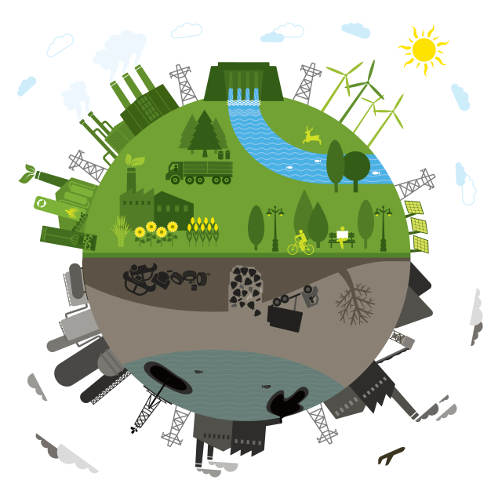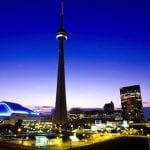Contents
Germany Moves Toward an Eco-Economy
Germany already leads the world in recycling, with its requirement that manufacturers take back their packaging and a system in which all items marked with a Green Dot are picked up by a recycling consortium paid for by business.
However, under the new Recycling and Waste Management Act, which took effect October 7, 1996, the government has taken the first steps to put the whole economy onto a closed-loop basis. Manufacturers are now responsible for the entire life-cycle of a product, from the moment its materials leave the ground until the time that it is recycled, and must take into account the energy used for the product’s transportation as well.
The new law gives priority to waste avoidance by requiring the use of low-waste product designs and closed-loop approaches to waste management, and by promoting consumer behavior oriented to the purchase of low-waste and low-pollution products. The recycling of materials is given priority over incineration to recover energy, and regulations requiring the use of renewable resources, though less stringent, help establish the basis for circular flow of resources through the economy.
Having laid down the new principles, the Act requires federal and local governments to follow up with specific ordinances, targeting product responsibility, the duty of waste recovery, the duty of waste disposal, and the duty to provide ‘institutional transparency’ — i.e. to eliminate secrecy. No-one knows when these ordinances will appear or what they will look like, so industry is forced to anticipate the new rules by taking steps to realize a circular economy in each particular field.
In 1994, for example, the German paper industry committed itself to a 60 percent recovery rate for paper by the year 2000, and this year the automotive industry agreed to take back and recycle its cars. BMW has built an entire plant in Munich to recycle cars, especially the 20 or so plastic components that are tough to recycle.
Cooperation to meet the new regulations and establish closed-loop materials cycles is happening within industries (e.g. the automotive and electronics industries), within sectors (e.g. paper, glass, metals, and plastics sectors), and within regions, which combine the different flows of individual companies into an overall materials-flow cycle. — Guy Dauncey, EcoNews
Dutch Eco-Investments Now Tax Free
In an effort to speed development of environmentally-friendly projects and technologies, the Dutch government has made “green” investments tax-free. Projects ranging from wind energy to “sustainable housing projects” now have a much easier time locating financing at attractive interest rates.
Affluent investors seeking to avoid high Dutch income taxes of up to 60 percent are flocking to the new eco-investments. “Green funds” set up by large banks are oversubscribed, and are now thought to total more than one billion gilders ($600 million). A recent offering of wind energy funds by the ABN-AMRO bank sold out within days. Wind energy, solar energy, energy conservation, organic agriculture, and forest conservation programs have particularly benefitted.
Housing projects that use alternative energy technologies, renewable building materials, graywater systems, and other environment-friendly approaches were recently added to the list of tax-free green investments. Banks such as ASN (the General Savings Bank) now offer “green mortgages”. For example, one ecological housing development north of Amsterdam was able to obtain financing at 4.9 percent interest, well below the normal 6.2 percent rate. The money saved helped finance alternative energy improvements. (The International Green Planner)
Green Building in Zimbabwe
Countering the trend toward western-style air-conditioned glass towers, a new development in the Zimbabwean capital of Harare offers a more ecologically-appropriate building model for sub-Saharan Africa.
The Pearce Partnership architects persuaded the developer to ventilate, heat and cool the 31,600-square-foot building naturally. Containing both offices and retail, the edifice uses enormous thermal mass, exterior walls shielded from sunlight, and small windows on the north (sunny) side to keep itself cool.
Fans bring in cooler air at night to cool the building mass, which then maintains lower temperatures during the hot daytime. Meanwhile, warm exhaust air from the offices during the day rises out of the building through 48 chimneys. Heating and cooling strategies were designed by the engineering firm of Ove Arup & Partners. (The Architectural Review/Greenclips)
Planning for Sustainability in Latvia
In its arduous transition from Soviet control, Riga, the capital of the Republic of Latvia, has developed a new Master Plan which will undo years of often-disastrous centralized planning. This city of 900,000 on the Baltic Sea retains an historic core with some streets and buildings dating back to the 13th century. The new plan focuses on preserving this “old town” as well as later concentrations of art nouveau and romantic eclecticism-style buildings that led UNESCO to recommend that the city be designated an Art Nouveau Heritage City.
The Master Plan also drops Soviet intentions to build massive new road networks, and aims instead to preserve the city’s excellent public transit system. Currently the mode split between transit and cars is 80:20 — unheard of by western standards. The Plan also proposes to reclaim waterfronts, uncover river channels, and form a green network as a key element of the city.
Perhaps most amazingly, the new Plan was created with extensive public input. Whereas previously the single copy of the city’s land use plan hung behind a curtain in the Mayor’s office, this time around the city printed 5,000 copies of a draft plan and distributed these free to citizens. (Ambio)
Resisting Malls in Europe
Neighborhood stores are a way of life in many European communities, and contribute heavily to the pedestrian-oriented flavor of these cities and local neighborhood life. However, a continuing invasion of large retailers and shopping malls threaten to bring American-style suburban sprawl and mall shopping patterns instead. In the face of this threat, European governments are seeking ways to preserve small businesses and city centers.
Italy is considering a three-year moratorium on new malls. England has stiffened restrictions on shopping centers, which were allowed to proliferate during the Thatcher era. Germany now limits new malls except in the east. In France, where large retailers now control 90 percent of retail trade, the government of Jacques Chirac is requiring government approval for new food stores of as little as 3,000 square feet. (The New York Times)
Japanese Courts Find Roadbuilders Guilty
Since the late 1970s 519 lawsuits have been brought in Japanese courts by victims of pollution-related illnesses seeking damages against roadbuilders. The courts have recognized a cause-and-effect relationship between highway constructions, nitrogen dioxide emissions, and respiratory ailments. More than 4 billion yen (about $40 million) has been paid to the plaintiffs in settlements.
In a July 1995 ruling, for example, Osaka District Court held that the central Japanese government and the Ilanshin Expressway Public Corporation are responsible for air pollution along roads in Nishiyodogawa Ward. The two defendants were ordered to pay 65 million yen (about $500,000) to 18 patients. Such rulings help establish the principle that agencies should consider the negative effects of roadbuilding on people and communities when deciding transportation policy. (Jiji Press/EcoCity Report)
Shorts
The Czechs and Austrians have created a 250-mile long Czech Greenway connecting Vienna and Prague with foot, bicycle, and horse trails as well as canoe waterways. (Waterfront World)
Higher-density, “neotraditional” planning is catching on in the Canadian province of Ontario, with at least 12 projects underway. One such community, the village of Montgomery near Toronto, features three- and four-story townhouses on 20- to 30-foot wide lots, with wooden balconies, front porches, and garages in the rear. (The New York Times)
With its 60 million bikes outnumbering its 40 million automobiles, Germany is spending more than $1 billion over five years to construct bike paths. (What’s Next)
Frankfurt’s new 62-story Commerzbank Building includes 13 interior gardens of 15 by 36 meters as well as natural lighting and ventilation. (Greenclips/ENR)
Britain’s 1996 Green Building of the Year is a 6,000 square-meter administration and student building at Oxford which uses only natural and recycled materials, recycles graywater and runoff from the roof for toilets, and employs condensing gas boilers and low energy lighting. (Greenclips/Building for a Future)
In an innovative alternative cooling technology, the Rijksmuseum in Amsterdam is avoiding the cost and energy use of air conditioning by pumping icy water into underground tanks during the winter and recirculating it during the summer. (Earth Island Journal)
Scientists at the Shell oil company predict that by the year 2050 renewable energy sources will contribute almost as much to global energy demand as coal, oil, natural gas and nuclear combined. (Solar Mind)
One of the greatest obstacles to sustainable development is growing global inequality. According to the United Nations Development Program, the ratio of the income of the richest 20 percent of the world’s population to the poorest 20 percent has more than doubled over the past three decades, from 30:1 to 61:1. The net worth of the 358 richest people in the world now equals the combined income of the poorest 2.3 billion, who comprise 45 percent of the world’s population. (UNDP Choices)







